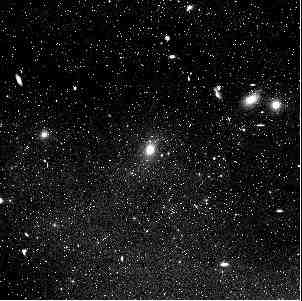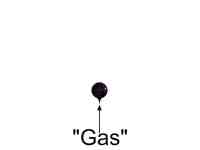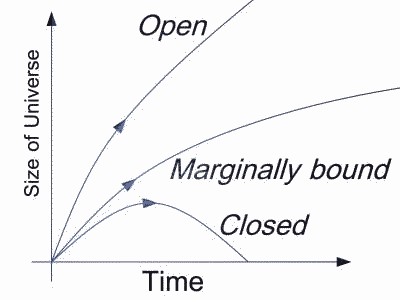


THE END
We can see further examples of stability on the much larger scale. Galaxies are very large clusters of stars, this time of order of a billion stars all orbiting round a common centre of mass. In this busy highway stars can collide and readjust their motions or simply coalesce. Galaxies come in all sorts and sizes. We have Elliptical galaxies, Spiral galaxies and Irregular galaxies. Some are fairly benign such as our own Milky Way Galaxy (which is a spiral galaxy) but others can be much more energetic such as the Seyfert galaxies, the Radio galaxies and the Quasars.
At the next level up we have Clusters of Galaxies, families of galaxies in motion round each other but bound together by gravitation. Some of these families are small such as our own which contains 24 galaxies (including the small and Large Magellanic Clouds and the giant spiral galaxy Andromeda) . Then there are the giant families containing in excess of a thousand galaxies such as the Coma and Perseus clusters. Although we do not see any motion in real time, observations do confirm the internal motion of these galaxies in the cluster. Again, large scale collisions occur between galaxies which play an important role in the evolution of the galaxies themselves.

IMAGE - The Virgo Galaxy cluster
There is some suggestion that there may be even larger associations of galaxies, that is clusters of clusters of galaxies but whether these are indeed gravitationally bound is debatable.
But of course the real thing which prevents the Universe from having collapsed long ago is simply that it is in a state of expansion; attack is said to be the best form of defence! Why it is expanding we do not know; it simply came into being in that condition in the Big Bang. This discovery by the astronomer Hubble that the Universe is expanding was one of the most significant discoveries of the 20th Century. Einstein, who preceded Hubble, did not know this. He could not understand why the Universe appeared to be stable so he invented the Cosmological Force which was a kind of antigravity force to keep the Universe up. Subsequently after Hubble's discovery he admitted it was the biggest mistake of his life (although interestingly cosmologists are still attempting to search for and quantify this force).

IMAGE - The expansion of the Universe
The expansion of the Universe can be represented as the surface of an inflating balloon. As the balloon expands, the distance between two points increases. (i.e. the Universe does not expand into a previously empty void. Rather, space itself is expanding !! This is not an easy concept to grasp and if you have not encountered it before, it may sound like doubletalk)
Please move mouse over image
Gravity counteracts the expansion and will slow it down. Whether it will do so before the material in the Universe is so far apart that gravity's influence can no longer be felt, or whether it will stop the expansion and start the big contraction ending up in the Big Crunch is still to be determined. There is even a possibility (high, in some peoples estimate) that the Universe will just manage to expand to infinity and remain there.
The outcome simply depends on what the density of the Universe actually is since it is the density of the matter which dictate the magnitude of the gravitational pull. If it is greater than the so-called critical density the Universe will eventually collapse; if less, it will expand for ever. Tantalisingly enough the measured density is surprisingly quite close to the critical density. This is why it would be quite nice to observe and account for the mass that gravity has already taken out of our view in its formation of all the dwarf and compact objects which we cannot see.

IMAGE - The ultimate fate of the Universe
The fate of the Universe depends on the density. If the density is below the critical density, the Universe will expand forever (open Universe) and if the density is above the critical density, it will eventually collapse in on itself (closed Universe). A few scientists believe the density is equal to the critical density. Such a Universe will just barely manage to continue expanding forever (marginally bounded Universe)
Whether gravity ultimately wins out on the large scale is a matter of great interest to us all, but I wouldn't hold your breath if I was you.

